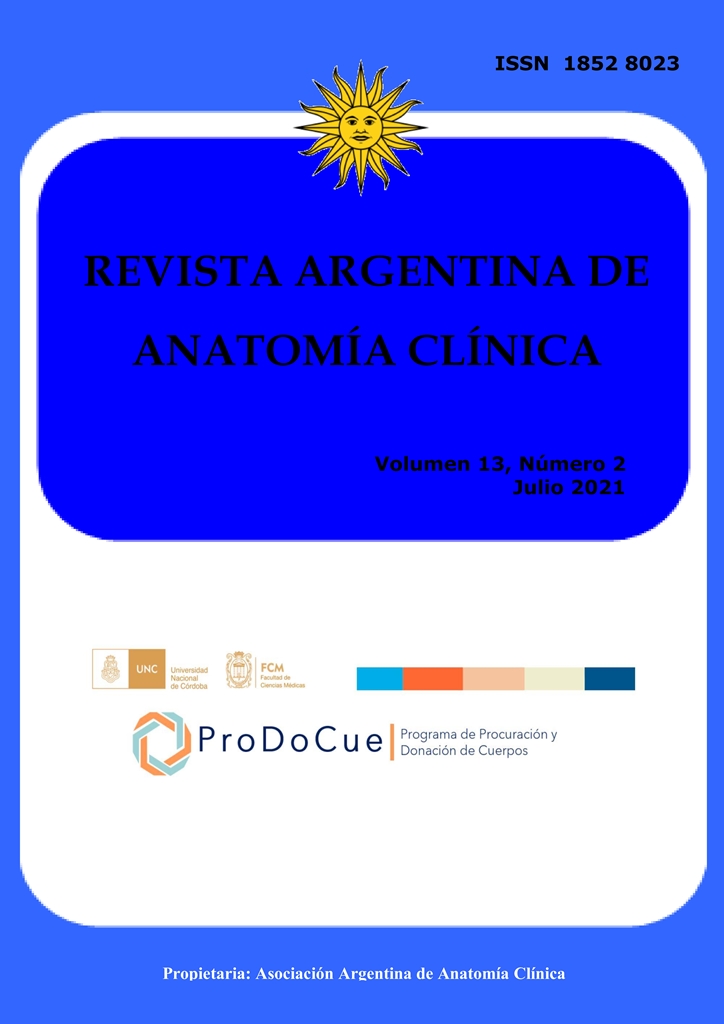Components separation technique replicated in cadaveric material.
DOI:
https://doi.org/10.31051/1852.8023.v13.n2.32628Keywords:
Abdominal wall, anatomy, incisional hernia.Abstract
Introduction: the anterolateral abdominal wall includes 4 muscles: external oblique, internal oblique, transverse abdominis and rectus abdominis, which allow it to participate in diverse functions. These can be affected by an incisional hernia. When they achieve huge size, its repair may represent great challenge to the general surgeon. Eventhroplasty using non-absorbable mesh is the gold standard treatment, but it can require additional procedures. Component separation technique is a group of anatomic-based procedures which allow the increase of abdominal volume. The aim of this report was to reproduce the component separation technique in cadaveric material, and a literature review. Materials and Methods: two adult cadavers of both sexes were used, fixed in formaldehyde. The external oblique muscle was liberated as described in the anterior component separation technique. Posterior component separation was made through a retro-rectal plane, and then progressing the dissection laterally. Results: Medial advancement of the muscles was achieved. Conclusions: knowledge of anterolateral abdominal wall anatomy is the basis for performing component separation technique. Training on cadaveric material is one of the first steps for surgical training.
Downloads
References
Ahmed N, Devitt KS, Keshet I, Spicer J, Imrie K, Feldman L, Cools-Lartigue J, Kayssi A, Lipsman N, Elmi M, Kulkarni AV, Parshuram C, Mainprize T, Warren RJ, Fata P, Gorman MS, Feinberg S, Rutka J. 2014. A systematic review of the effects of resident duty hour restrictions in surgery: impact on resident wellness, training, and patient outcomes. Ann Surg. 259(6):1041-53.
Balta JY, Twomey M, Moloney F, Duggan O, Murphy KP, O'Connor OJ, Cronin M, Cryan JF, Maher MM, O'Mahony SM. 2019. A comparison of embalming fluids on the structures and properties of tissue in human cadavers. Anat Histol Embryol. Jan;48(1):64-73.
Basta MN, Kozak GM, Broach RB. Messa CA, Rhemtulla I, DeMatteo RP, Serletti JM, Fischer JP. 2019. Can We Predict Incisional Hernia? Development of a Surgery-specific Decision–Support Interface. Annals of Surgery 270 (3): 544-553.
Burger JW, Lange JF, Halm JA, Kleinrensink GJ, Jeekel, H. 2005. Incisional Hernia: Early Complication of Abdominal Surgery. World J. Surg. 29 (12):1608-1613.
Carbonell AM, Cobb WS, Chen SM. 2008. Posterior components separation during retromuscular hernia repair. Hernia. 12: 359-362.
Carey JN, Minneti M, Leland HA, Demetriades D, Talving P. 2015 Perfused fresh cadavers: method for application to surgical simulation; Am J Surg 210: 179–187.
Gilbody J, Prasthofer AW, Ho K, Costa ML. 2011. The use and effectiveness of cadaveric workshops in higher surgical training: a systematic review. Ann R Coll Surg Engl 93: 347–352.
Heller L, McNichols CH, Ramirez OM. 2012. Component separations. Semin Plast Surg. 26(1):25–8. 35.
Hernández A. 2016. Tratamiento actual de grandes eventraciones con las técnicas de separación de componentes anteriores y posteriores. Revista Hispanoamericana de Hernia 4:(1): 1-3.
Kapandji I. 2006. Fisiología Articular. Tomo 3. Madrid: Panamericana. 6ª Edición.
Krpata DM, Blatnik JA, Novitsky YW, Rosen MJ. 2012. Posterior and open anterior component separation: A comparative analysis. Am. J. Surg. 203(3): 318–322.
Latarjet, Ruiz Liard. Anatomía Humana. Tomo 2. Buenos Aires: Panamericana. 4 ª Edición. 1305-1330.
Le Huu Nho R, Mege D, Ouaïssi M, Sielezneff I, Sastre B. 2012. Incidence and prevention of ventral incisional hernia. J. Visc. Surg. 149(5): 3-14.
López-Cano M, Martin-Dominguez LA, Pereira JA, Armengol-Carrasco M, García-Alamino JM. 2018. Balancing mesh-related complications and benefits in primary ventral and incisional hernia surgery. A meta-analysis and trial sequential analysis. PLoS One.13 (6): e0197813.
Lowe JB, Lowe JB, Baty JD, Garza JR. 2003. Risks Associated with “Components Separation” for Closure of Complex Abdominal Wall Defects. Plast Reconstr Surg. 1;111(3):1276–83.
Luijendijk RW, Hop WCJ, Van Den Tol MP, De Lange DCD, Braaksma MMJ, Ijzermans JNM, Boelhouwer RU, de Vries BC, Salu MK, Wereldsma JC, Brujininckx, Jeekel J. 2000. A comparison of suture repair with mesh repair for incisional hernia. N Engl J Med.10;343(6):392–398.
Novitsky YW, Elliott HL, Orenstein SB, Rosen MJ. 2012. Transversus Abdominis Muscle Release: A novel approach to posterior component separation during complex abdominal wall reconstruction. Am. J. Surg., 204(5): 709–716.
Ramírez OM, Ruas E, Dellon AL. 1989. “Components Separation”. Method for Closure of Abdominal-Wall Defects: An Anatomic and Clinical Study. Plastic and Reconstructive Surgery, 86 (3): 519-526.
Rives J, Pire J C, Flament J B, Palot J P, Body C. 1985. Treatment of large eventrations. NeW therapeutic indications apropos of 322 cases. Chirurgie, 111(3): 215–225.
Reznick RK, MacRae H. N Engl J Med 2006. Teaching surgical skills – changes in the wind; 355: 2664–2669.
Stoppa RE. The Treatment Of Complicated Groin and incisional hernias. 1989. World J. Surg.,13(5): 545-554.
Sugand K, Abrahams P, Khurana A. 2010 The anatomy of anatomy: a review for its modernisation; Anat Sci Educ 3: 83–93.
Testut L, Latarjet A. 1984. Tratado de Anatomía Humana. Tomo 2. Barcelona: Salvat editores. 9 ª Edición. 352-354.
Tong WM, Hope W, Overby DW, Hultman CS. 2011. Comparison of Outcome After Mesh-Only Repair, Laparoscopic Component Separation, and Open Component Separation. Ann. Plast. Surg.; 66 (5): 551-556.
Traynor O. 2011. Surgical training in an era of reduced working hours: proceedings of the second international conference on surgical education and training. Surgeon. 9:S1eS2.
Downloads
Published
How to Cite
Issue
Section
License
Copyright (c) 2021 María F. Ignatov Galan, Sofía G. Martínez Ventura, Daiana López Gil , Emilia Cerchiari Campodónico, Eduardo Olivera Pertusso

This work is licensed under a Creative Commons Attribution-NonCommercial 4.0 International License.
Authors retain copyright and grant the journal right of first publication with the work simultaneously licensed under a Creative Commons Attribution License that allows others to share the work with an acknowledgement of the work's authorship and initial publication in this journal. Use restricted to non commercial purposes.
Once the manuscript has been accepted for publications, authors will sign a Copyright Transfer Agreement to let the “Asociación Argentina de Anatomía Clínica” (Argentine Association of Clinical Anatomy) to edit, publish and disseminate the contribution.



